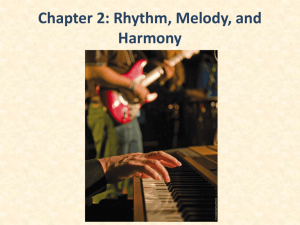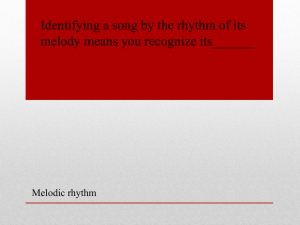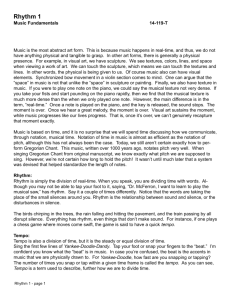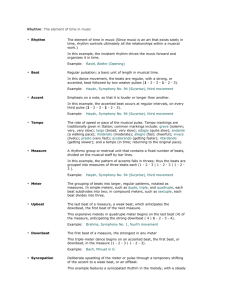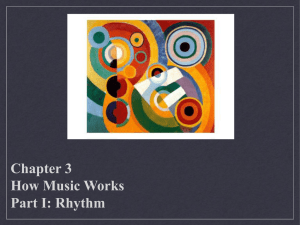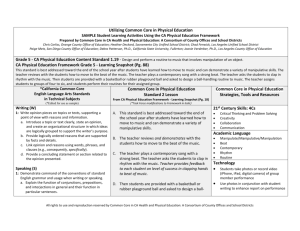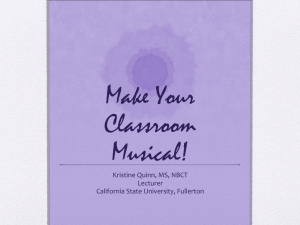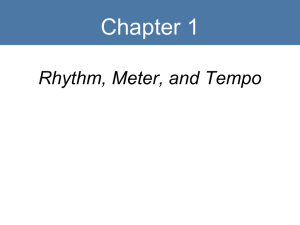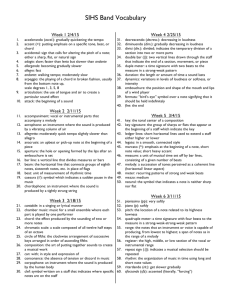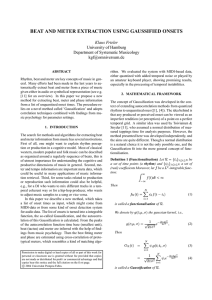Music Fundamentals
advertisement
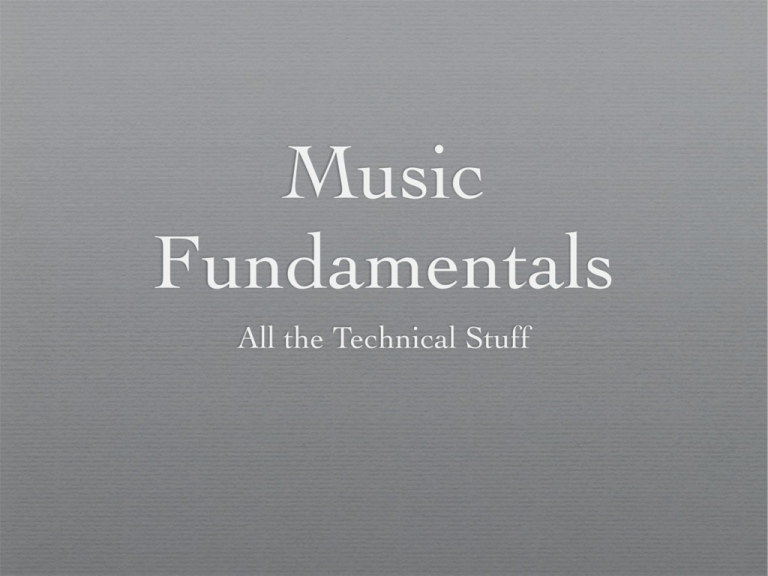
Music Fundamentals All the Technical Stuff Pitch ✦ ✦ Highness or lowness of a sound ✦ Acousticians call it frequency ✦ Musicians call it pitch The example moves from low, to medium, to high pitch. Dynamics ✦ The volume or loudness of a sound. ✦ Musical terminology is in Italian: ✦ piano means “soft” ✦ forte means “loud” ✦ mezzo qualifies as “medium” ✦ -issimo intensifies Dynamics ✦ pp — pianissimo (very soft) ✦ p — piano (soft) ✦ mp — mezzo piano (medium soft) ✦ mf — mezzo forte (medium loud) ✦ f — forte (loud) ✦ ff — fortissimo (very loud) Dynamics ✦ Gradual changes of dynamics are indicated by the terms: ✦ crescendo (getting louder) ✦ decrescendo (getting softer) Beat ✦ The underlying pulse which we hear in a piece of music — it isn’t necessarily there as a sound, but is felt as a pattern. Beat ✦ In this example, a drum tap is added to bring out the beat. Beat ✦ This is the same example without the added tap. Accent and Meter ✦ ✦ When one beat seems stronger than the others, the beats tend to fall into patterns: ONE two ONE two, or ONE two three ONE two three, etc. Those patterns are called a meter. Meter ✦ ✦ The example we’ve been hearing (by J.S. Bach) is in duple (ONE two) meter. This version adds taps that reflect the meter. Meter ✦ Here’s an example in triple meter (ONE two three). Meter ✦ The same piece, without the taps. Rhythm ✦ In the most general sense rhythm refers to the time element in music. Rhythm ✦ In a more specific sense, it refers to the arrangements of notes (in time) in a piece of music. ✦ Rhythm is usually structured by the beat and the meter, but it is not the same. Rhythm ✦ In this example, the rhythm adheres pretty closely to the beat, with only a few departures. Notes Strong and weak beats Rhythm ✦ ✦ Rhythm that is placed strongly against the beat in some way is called syncopated rhythm or just syncopation. The following example—the “Maple Leaf Rag”—demonstrates how the notes don’t necessarily fall evenly on the beat. Tempo ✦ ✦ The overall speed of a piece of music. Can be measured by the metronome marks, which indicate precisely how many beats there should be per second. Tempo ✦ The Italian terminology to indicate tempo is still in wide use ✦ ✦ It isn’t as precise as metronome marks But it allows for more interpretation, latitude, and also carries some emotional connotation. Tempo ✦ ✦ Some standard tempo markings ✦ Adagio—slow ✦ Andante—walking ✦ Moderato—moderate ✦ Allegretto—fast-ish ✦ Allegro—fast ✦ Presto—very fast See the textbook for more Intervals ✦ ✦ An interval is the distance between any two notes. Intervals can be consonant or dissonant ✦ Consonant: the notes are pleasing together ✦ Dissonant: the notes clash with each other. Intervals ✦ Consonant intervals Intervals ✦ Dissonant intervals Intervals ✦ ✦ A half-step is the shortest possible distance between two notes. A whole-step is two half-steps. Scales ✦ Combinations of whole and half steps which together make up the pitches used in a musical composition. Scales ✦ There are many different kinds, but the most common ones in Western music are: ✦ Chromatic ✦ Major ✦ Minor Chromatic Scale ✦ Consists of nothing but half steps. The Major Scale ✦ All whole steps, except between notes 3 & 4, and notes 7 & 8. The Minor Scale ✦ ✦ All whole steps except between 2 & 3, and 5 & 6. Typically, the next-to-last note (7th) is raised; Western music prefers a half step between 7th and 8th notes. Keyboards and Scales ✦ ✦ The keyboard (piano, harpsichord, celesta, organ, synthesizer, etc.) evolved along with Western music. It was originally designed around the major scale. The outlined area is a major scale Mode and Key ✦ Major and minor scales are representations of mode—the organization of the tones within a musical composition. Mode and Key ✦ ✦ When a piece of music uses a particular set of notes (those making up the major or minor scales, for example) we say that the piece is in that mode. So a piece which employs the set of notes of the major scale is in major. Mode and Key ✦ Mode has a great deal to do with the perceived emotional quality of music. Mode and Key ✦ “Happy Birthday” in major, as we usually hear it. Mode and Key ✦ “Happy Birthday” in minor, as we don’t as a rule hear it. Mode and Key ✦ A scale can begin on any note—whether it’s major or minor depends on the order of whole and half steps that follows. ✦ The note on which the scale begins is the tonic. ✦ A key is a combination of tonic and mode. Mode and Key ✦ Bach’s First Prelude in C Major Mode and Key ✦ Bach’s First Prelude in A Major Mode and Key ✦ ✦ Pieces of music will sometimes change key during their course This is called modulation. Texture ✦ The term texture refers to the blend of various sounds and melodic lines occurring in music. Monophony ✦ A single unaccompanied melody. Polyphony ✦ Two or more melodies are heard simultaneously. ✦ ✦ The melodies are independent and of approximately equal interest. Can be imitative or non-imitative. Imitative Polyphony ✦ Two melodies; the second (lower) is a copy of the original, just starting at a later time. Non-Imitative Polyphony ✦ ✦ Two melodies; the second (lower) is noticeably different from the original. The second melody may start later than the original, or at the same time. Homophony ✦ ✦ ✦ There is only one melody of real interest That melody is combined with other sounds, which act in a supportive role. For example, singing a song while playing chords on a guitar is homophonic texture.

